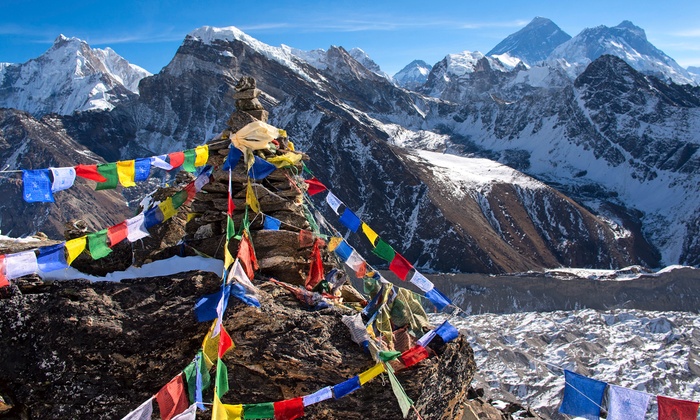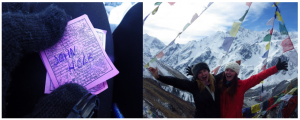
Prayer Flags – One of the most popular symbol and practice of Buddhism
Experiences:
Learn and experience offering prayer flags during your trip to Tibet and Nepal.
Highlights:
- Receive both paper prayers flags and prayer flag made of cloth.
- Learn and experience how to perform prayer flag offerings.
- Great opportunity to pray for all your family, friends and people around the world.
- Take part in one of the important practices of Tibetan Buddhism.
If you travel to any hills, mountains, high passes in the Himalayan regions you will notice colorful rectangle materials made of cloth hanging on a string blowing and quite often making noticeable sounds by strong winds flapping on the flags. Prayer flags are called Lungta in Tibetan. Whether you travel to Base Camps of the Himalayas, highest lakes, and mountain passes, sacred sites you will notice such prayer flags or Lungtas being offered.
Different type of Prayer Flags or Lungta:
There are mainly two types of Prayers flags: Vertical which is called Dharchog and Horizontal which is called Lungta.

(1) Dharchog is mainly large single rectangle flag attached to pole through the long string at the edge. You can find Dharchong in Monasteries, houses, sacred sites, Dharchog are changed every year during the Tibetan New Year. (2) Lunga: Lungtas are of rectangular sometime square shape and usual place one end to higher elevation and other end to lower elevation to give maximum wind blow. Lungta are usually place on top of the temple, high mountain pass and any sacred sites.
Paper Lungta of different size are used specially places where there are no place to attach or empty land so you just pray and throw the prayers flags.
BATE organizes prayer flag offering ceremony conducted by our local Tibetan Guides and teaching of the meaning to the guests in every trip.

What are Prayers Flags made of?
Prayer flags or Lungtas are normally made of pure cotton clothes that are very light and are sequence of 5 colors (1) blue symbolizes the sky and space, (2) white symbolizes the air and wind, (3) red symbolizes fire, (4) green symbolizes water, and (5) yellow symbolizes earth. As per the ancient Tibetan medicine health and harmony are produced through the balance of the five elements.
Prayer flags have picture of a powerful horse bearing three Jewels on its back. Tah which means horse and is a symbol of speed and transformation of bad fortune to a good fortune. Three Jewels symbolizes three basic foundation of Buddhism (1) Buddha, (2) Dharma (teachings of Buddha) and (3) Sangha (Buddhist community).
There are approx 400 sacred mantras dedicated to various great enlighten beings or Buddhist tantric masters such as Padmasambhava, God of compassion Avoloketswara, Bodhisattva and scholar Manjushri .
Meaning or Function of Prayers flags:
Prayer flags are used to offer prayers for peace, compassion and wisdom around the world. Tibetans believe that Prayers and Mantras will be blown by the wind to spread goodwill and harmony, therefore prayers flags are thought to bring benefit to the living beings.
By hanging prayer flags in high places the Lungta will carry the blessings depicted on the flags to all beings. As wind passes over the surface of the flags, which are sensitive to the slightest movement of the wind, the air is purified and sanctified by the mantras.